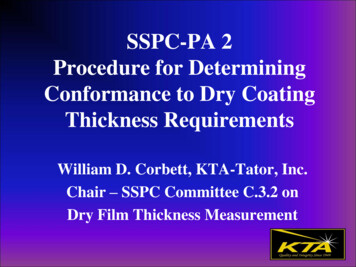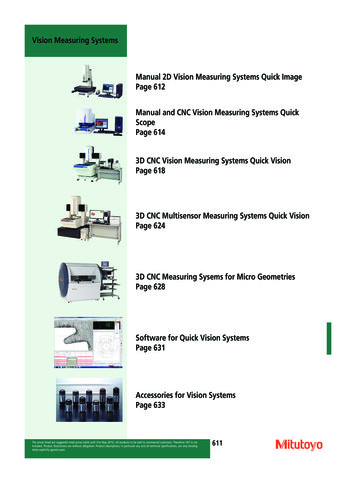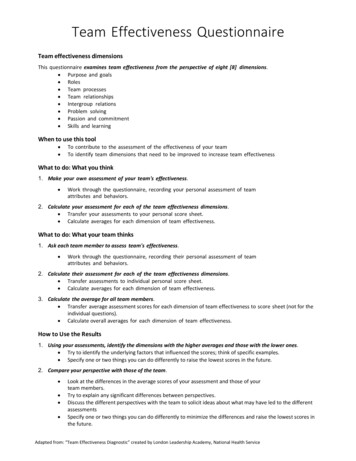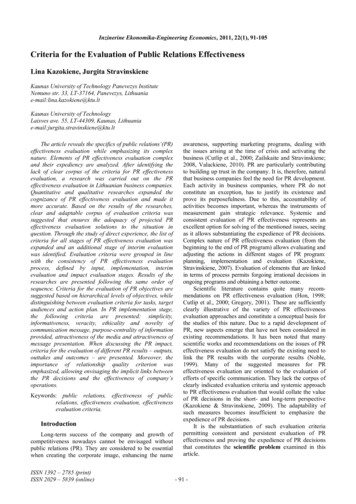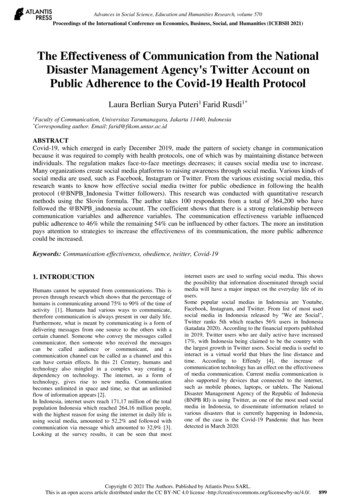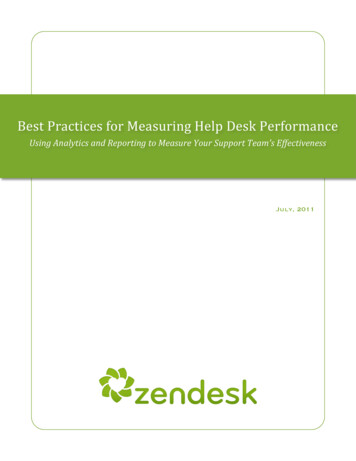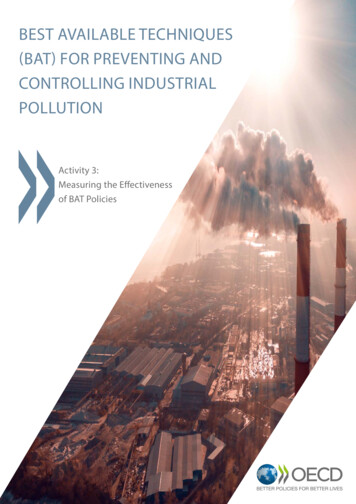
Transcription
BEST AVAILABLE TECHNIQUES(BAT) FOR PREVENTING ANDCONTROLLING INDUSTRIALPOLLUTIONActivity 3:Measuring the Effectivenessof BAT Policies
Best Available Techniques (BAT) forPreventing and Controlling IndustrialPollutionActivity 3: Measuring the Effectiveness of BATPolicies
This document was approved by the Expert Group on Best Available Techniques in May2019, and is published under the responsibility of the Joint Meeting of the ChemicalsCommittee and the Working Party on Chemicals, Pesticides and Biotechnology.Please cite this publication as:OECD (2019), Best Available Techniques (BAT) for Preventing andControlling Industrial Pollution, Activity 3: Measuring the Effectiveness ofBAT Policies, Environment, Health and Safety, Environment Directorate, OECD.Photo credits: Cover LALS STOCK/Shutterstock.com OECD 2019Applications for permission to reproduce or translate all or part of this material should bemade to: Head of Publications Service, RIGHTS@oecd.org, OECD, 2 rue André-Pascal,75775 Paris Cedex 16, France
ABOUT THE OECDAbout the OECDThe Organisation for Economic Co-operation and Development (OECD) is anintergovernmental organisation in which representatives of 36 industrialised countries inNorth and South America, Europe and the Asia and Pacific region, as well as the EuropeanCommission, meet to co-ordinate and harmonise policies, discuss issues of mutual concern,and work together to respond to international problems. Most of the OECD’s work iscarried out by more than 200 specialised committees and working groups composed ofmember country delegates. Observers from several countries with special status at theOECD, and from interested international organisations, attend many of the OECD’sworkshops and other meetings. Committees and working groups are served by the OECDSecretariat, located in Paris, France, which is organised into directorates and divisions. TheEnvironment, Health and Safety Division publishes free-of-charge documents in twelvedifferent series: Testing and Assessment; Good Laboratory Practice and ComplianceMonitoring; Pesticides; Biocides; Risk Management; Harmonisation of RegulatoryOversight in Biotechnology; Safety of Novel Foods and Feeds; Chemical Accidents;Pollutant Release and Transfer Registers; Emission Scenario Documents; Safety ofManufactured Nanomaterials; and Adverse Outcome Pathways. More information aboutthe Environment, Health and Safety Programme and EHS publications is available on theOECD’s World Wide Web site (www.oecd.org/chemicalsafety/)This publication was developed in the IOMC context. The contents do not necessarilyreflect the views or stated policies of individual IOMC Participating Organizations. TheInter-Organisation Programme for the Sound Management of Chemicals (IOMC) wasestablished in 1995 following recommendations made by the 1992 UN Conference onEnvironment and Development to strengthen co-operation and increase international coordination in the field of chemical safety. The Participating Organisations are FAO, ILO,UNDP, UNEP, UNIDO, UNITAR, WHO, World Bank and OECD. The purpose of theIOMC is to promote coordination of the policies and activities pursued by the ParticipatingOrganisations, jointly or separately, to achieve the sound management of chemicals inrelation to human health and the environment.BEST AVAILABLE TECHNIQUES (BAT) FOR PREVENTING AND CONTROLLING INDUSTRIAL POLLUTION OECD 2019 3
FOREWORDForewordThe Best Available Techniques (BAT) concept is an evidence-based, multi-stakeholdertool that supports the establishment of legally binding emission limit values inenvironmental permits, to effectively prevent and control industrial emissions to air, waterand soil. The European Union’s Industrial Emissions Directive defines BAT as "the mosteffective and advanced stage in the development of activities and their methods ofoperation, indicating the practical suitability of particular techniques for providing the basisfor emission limit values and other permit conditions designed to prevent and, where thisis not practicable, to reduce emissions and the impact on the environment as a whole".By implementing BAT-based policies, governments and industry enable a high level ofenvironmental and human health protection and contribute to achieving progress towardsSustainable Development Goals, notably Target 12.4 on the environmentally soundmanagement of chemicals and waste. Further, the enforcement of BAT-based emissionstandards ensures a level playing field for industry and fosters more efficient operations.The implementation of BAT or similar concepts generally requires a high level ofresources. There is thus benefit in sharing experience and knowledge amongst OECDmember and partner countries on this issue. The OECD Joint Meeting of the ChemicalsCommittee and the Working Party on Chemicals, Pesticides and Biotechnology, at its 54thmeeting in February 2016, approved a new project on BAT for preventing and controllingindustrial chemical pollution. The project has been conducted with the financial assistanceof the European Union.The OECD’s BAT project sets out to strengthen the performance of BAT policies andpractices around the world by exchanging best practices amongst countries that alreadyhave a BAT-based policy in place, and by providing guidance to governments consideringadopting a BAT-based approach.The project consists of three activities: (i) compile information on policies and practicesembodying BAT; (ii) exchange experiences on how to gather information on techniquesand establish BAT; and (iii) assess methodologies for evaluation of the effectiveness ofpolicies and practices embodying BAT or similar concepts by using Pollutant Release andTransfer Register (PRTR) information or emissions monitoring data. The first two activitiesresulted in the following reports:i.Activity 1: Policies on BAT or Similar Concepts Across the World.ii.Activity 2: Approaches to Establishing BAT Around the WorldThis report is the final output of the third activity and presents the first comprehensive,cross-country analysis of data and methodologies for evaluating the effectiveness ofpolicies that aim to prevent and control industrial emissions using BAT or similar concepts.With ten chapters addressing specific countries or regions, the report examinesopportunities for, and barriers to, BAT policy impact assessment in Chile, the EuropeanUnion (EU) (including specific references to Germany, Sweden and the United Kingdom),BEST AVAILABLE TECHNIQUES (BAT) FOR PREVENTING AND CONTROLLING INDUSTRIAL POLLUTION OECD 2019 5
6 FOREWORDIndia, Israel, Kazakhstan, Korea, New Zealand, the People’s Republic of China (hereafterChina), the Russian Federation and the United States (US). In doing so, the report providesimportant guidance to countries seeking to evaluate their policies’ effectiveness or wishingto design data systems that can facilitate such evaluations. Where necessary, the report alsocomplements the Activity 2 report with new information on the countries’ BAT policies.The key findings from the ten country and region chapters are presented in Table 13.1.Information analysed in this report was collected through: (i) extensive contact withnational experts, notably the members of OECD’s designated Expert Group on BAT,through a survey and subsequent information exchange; and (ii) desk research, based onthe consultation of online websites, publications and other resources. The draft report wasreviewed at the Third Meeting of the Expert Group on BAT in October 2018.The report presents existing methodologies and projects for evaluation of the impact ofindustrial emissions policies using BAT or similar concepts, and demonstratesgovernments’ diverse approaches to such evaluations. It provides examples of assessmentstudies carried out at the local, national and supranational level. Further, the report providesan overview of available quantitative data, such as emissions and activity data, in all thecountries and regions covered. The first chapter of the report outlines considerations anddata needed for analysing the impact of a BAT policy. For those countries that haveadequate data readily available, i.e. Chile, the EU and the US, the report conducts ananalysis of SO2 and PM emission trends in the primary copper and aluminium productionsectors (Chapter 2. ). Due to limited information on the characteristics and emission limitvalues applying to each of the facilities investigated, as well as the recent or ongoingimplementation of new BAT-related requirements, the analysis does not draw definiteconclusions regarding the impact of the industrial emissions policies of each of the threejurisdictions.In the absence of countrywide, facility or installation level emissions monitoring data, casestudies can provide revealing insights into the effects of a policy at the local level. Thereport includes case studies from several different industrial sectors, including leadsmelting, leather tanning, aluminium production, pharmaceutical manufacturing, coppersmelting, large combustion plants, oil refinery, waste incineration, the chlor-alkali industry,common effluent treatment plants, zinc smelting, and the pulp and paper industry.Besides quantitative data sources, the report draws on qualitative information, i.e.stakeholder opinions, on the effectiveness of BAT-based policies. The stakeholdersconsulted for the development of this report include representatives of government,environmental NGOs, industry and academia.BEST AVAILABLE TECHNIQUES (BAT) FOR PREVENTING AND CONTROLLING INDUSTRIAL POLLUTION OECD 2019
ACKNOWLEDGEMENTSAcknowledgementsThis report is an output of the OECD Environment Directorate. It was prepared under thesupervision of the OECD's designated Expert Group on BAT and is published under theresponsibility of the Joint Meeting of the Chemicals Committee and the Working Party onChemicals, Pesticides and Biotechnology of the OECD. The report was prepared byMarit Hjort and Takaaki Ito (OECD Secretariat), and benefitted from consultancy work byAn Derden, Caroline Polders and Jan Duerinck (VITO). Review and comments fromKrzysztof Michalak, Jean-François Lengellé, Guy Halpern, Bob Diderich and Eeva Leinalaalong with the editing contribution of Hannah Thabet (OECD Secretariat) are gratefullyacknowledged. The authors of this report also drew on work conducted by, and input ofexpertise from staff of, the OECD Environment Directorate.Experts consulted for the development of this report include Annalisa Bortoluzzi and StefanDrees (Business at OECD, BIAC), Sergio Barrientos (ASIQUIM), Christian Brito (theChilean Ministry of Environment), Ian Hodgson and Alex Radway (Directorate-Generalfor Environment, the European Commission), Gianluca Cusano and Serge Roudier (JointResearch Centre, the European Commission), Klaus Ebert and Katja Kraus (the GermanFederal Environment Agency), Manoranjan Hota and Jatinder S. Kamyotra (independentenvironmental experts, India), Deepshikha Sharma (Innovation Centre, Embassy ofDenmark, New Delhi), Ayelet Ben Ami and Lihie Iuclea (the Israeli Ministry ofEnvironmental Protection), Aliya Shalabekova (the Kazakh Ministry of Energy), AliaBaimaganova, Abylaikhan Dauletalin and Saltanat Rakhimbekova (the KazakhInternational Green Investments and Technologies Center), Philgoo Kang, Cheulhong Kimand Jaewoong Lee (the Korean National Institute of Environmental Research), PeterDawson (the New Zealand Environmental Protection Authority), Liu Liyuan and ChenYang (the Beijing Advanced Science and Innovation Centre, Chinese Academy ofScience), Tatiana Guseva, Dmitry Skobelev, Alexander Sanzharovskiy and KirillSchelchkov (the Russian BAT Bureau, Environmental Industrial Policy Centre), SvetlanaSheynfield (UNIDO Center for International Industrial, Cooperation in the RussianFederation), Jamie McGeachy (the Scottish Environment Protection Agency), SpenceSeaman (the English Environment Agency), Husamuddin Ahmadzai (the SwedishEnvironmental Protection Agency), Stephen DeVito (the United States EnvironmentalProtection Agency, Office of Chemical Safety and Pollution Prevention), Cheryl Keenanand Brian Palmer (Eastern Research Group) and Gail Lacy (the United StatesEnvironmental Protection Agency, Office of Air and Radiation).The OECD BAT project has been produced with the financial assistanceof the European Union. The views expressed herein can in no way betaken to reflect the official opinion of the European Union.BEST AVAILABLE TECHNIQUES (BAT) FOR PREVENTING AND CONTROLLING INDUSTRIAL POLLUTION OECD 2019 7
8 TABLE OF CONTENTSTable of contentsAbout the OECD . 3Foreword . 5Acknowledgements . 7Abbreviations and acronyms . 13Definitions . 15Executive summary . 17Part I. Key elements of effectiveness evaluations of BAT policies . 19Evaluating the effectiveness of BAT policies . 211.1. The value of evaluation. 221.2. Approaches to effectiveness evaluation of BAT policies . 221.3. Useful data sources for analyses of the impact of BAT policies on emission trends . 251.4. Methodology for analysis of emission trends at installation level . 28Notes . 31Trends in emissions from copper and aluminium production . 332.1. Introduction and key findings . 342.2. Primary copper production . 352.3. Primary aluminium production . 38Annex 2.A. The production process for primary copper production . 43Annex 2.B. The production process for primary aluminium production . 45Notes . 46Part II. Country and region chapters . 47European Union. 493.1. BAT in the European Union . 503.2. Policy evaluation. 513.3. Available sources of data . 603.4. Case studies. 633.5. Conclusion . 68Notes . 69United States . 714.1. BAT and environmental permitting in the United States . 724.2. Policy evaluation. 724.3. Stakeholder opinions. 744.4. Available sources of data . 744.5. Case studies. 774.6. Conclusion . 85Notes . 86BEST AVAILABLE TECHNIQUES (BAT) FOR PREVENTING AND CONTROLLING INDUSTRIAL POLLUTION OECD 2019
TABLE OF CONTENTSChile . 875.1. BAT in Chile. 885.2. Policy evaluation. 915.3. Available sources of data . 925.4. Conclusion . 93Notes . 93Israel . 956.1. BAT in Israel . 966.2. Policy evaluation. 996.3. Available sources of data . 1016.4. Case studies. 1086.5. Conclusion . 114Notes . 115Korea . 1177.1. BAT and environmental permitting in Korea . 1187.2. Policy evaluation. 1187.3. Available sources of data . 1197.4. Case studies. 1207.5. Conclusion . 122Notes . 123Russian Federation. 1258.1. BAT in the Russian Federation . 1268.2. Policy evaluation. 1298.3. Available sources of data . 1318.4. Conclusion . 135Notes . 135India . 1379.1. BAT and environmental permitting in India . 1389.2. Policy evaluation. 1389.3. Available sources of data . 1399.4. Case studies. 1419.5. Conclusion . 144Note. 144People’s Republic of China. 14510.1. BAT in the People’s Republic of China. 14610.2. Policy evaluation. 14710.3. Available sources of data . 14910.4. Case studies. 15010.5. Conclusion . 155Notes . 155Kazakhstan . 15711.1. BAT in Kazakhstan . 15811.2. Policy evaluation. 16111.3. Available sources of data . 162BEST AVAILABLE TECHNIQUES (BAT) FOR PREVENTING AND CONTROLLING INDUSTRIAL POLLUTION OECD 2019 9
10 TABLE OF CONTENTS11.4. Conclusion . 163New Zealand . 16512.1. BAT in New Zealand . 16612.2. Policy evaluation. 16612.3. Available sources of data . 16712.4. Conclusion . 167Notes . 167Conclusion . 16913.1. Why a report on the evaluation of BAT policies? . 17013.2. Existing evaluation initiatives . 17013.3. Data requirements for evaluation of BAT-based policies . 17113.4. Strengths and limitations of existing BAT-based policies . 17213.5. The way forward . 173References . 180TablesTable 1.1. Options for expressing units for activity and emission factor in a quantitative analysis . 29Table 3.1. Specific emissions from the Aurubus copper smelting plant in 2009 and 2017 . 65Table 3.2. Discharge of metals to the receiving water (2017) . 67Table 4.1. Summary of PM Emission Standards for New and Existing Emission Units . 81Table 7.1. Sources of emissions monitoring data in Korea . 120Table 8.1. The three hundred key polluters in the Russian Federation, by region . 127Table 8.2. Manufacture of basic fabricated metal products (million tonnes) . 135Table 8.3. Annual changes in total aluminium production in the Russian Federation in relation tothe previous year . 135Table 9.1. Indian emission standards for thermal power plants . 142Table 10.1. Emission limit values for the Chinese lead and zinc industry . 151Table 10.2. Stack tests at inlet/outlet of air pollution control devices . 152Table 10.3. Mercury removal efficiencies of air pollution control devices. 152Table 13.1. Key findings from the ten chapters in Part 2 of the report . 175FiguresFigure 2.1. Historical trends in SO2 emissions in primary copper production . 36Figure 2.2. Specific SO2 emissions from primary copper production facilities expressed as kg pertonne of production in the EU, Chile and the US (2014) . 37Figure 2.3. SO2 emissions per unit of production in primary aluminium plants in the EU . 39Figure 2.4. SO2 emissions per unit of production in primary aluminium plants in the US . 40Figure 2.5. PM10 emissions per unit of production in primary aluminium facilities in Europe . 41Figure 2.6. PM10 emissions per unit of production in primary aluminium facilities in the US . 41Figure 2.7. Simplified representation of a primary copper smelter . 44Figure 2.8. Simplified representation of the aluminium production based on pre-baked anodes . 45Figure 3.1. PM equivalent emissions from large combustion plants in the EU, 2007-15 . 52Figure 3.2. Methodology for assessing the potential emission reductions delivered by BATConclusions adopted under the IED . 54Figure 3.3. Process flow sheet for the Rönnskär smelter in Sweden . 66BEST AVAILABLE TECHNIQUES (BAT) FOR PREVENTING AND CONTROLLING INDUSTRIAL POLLUTION OECD 2019
TABLE OF CONTENTS 11Figure 4.1. Comparison of economic growth and emissions to air in the US, 1970-2017 . 73Figure 4.2. Trends in air pollution emissions in the US, 1990-2017 . 73Figure 4.3. Annual TRI reporting cycle . 76Figure 4.4. TRI Chemicals Released and Managed as Waste Reported by the PharmaceuticalIndustry. 83Figure 4.5. Quantities of Key Solvents Managed as Waste vs Quantities of all Other TRI ChemicalsManaged as Wast
policies and practices embodying BAT or similar concepts by using Pollutant Release and Transfer Register (PRTR) information or emissions monitoring data. The first two activities resulted in the following reports: i. Activity 1: Policies on BAT or Similar Concepts Across the World. ii. Activity 2: Approaches to Establishing BAT Around the World





